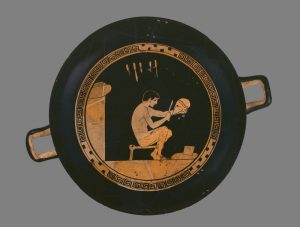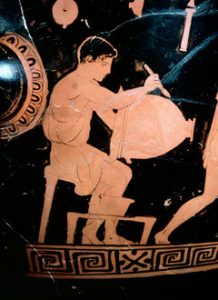Working from Home
Jessie Simpson
As is discussed elsewhere in this book, some of the everyday chores of the ancients were quite different from ours in North America today. One chore was that of wool working. Women were expected to weave cloth and fashion clothing for the household. They worked on both standing and handheld looms and sometimes owned enslaved people to either do this work for them or help them with this work. The ability to create enough cloth for your entire family was certainly the ideal, but not always the reality for all families of different statuses. People of middling and lower classes, for example, may have had to outsource this work, leading to the industrial side of wool working which could easily take place within the home. Outsourcing is how some of the other chores of the home became industrialised as well. Below, you can see an image taken from an ancient attic oil flask showing the various stages of wool working, with the most well-known, weaving, in the centre. This image shows the number of stages and people that could be involved in the creation of one garment or even just one piece of fabric. The addition of other people and even other looms could lead to more productivity and assist the household industry to thrive. You can see the process of weaving on one of these looms in this linked video.

Quite often, enslaved people were a part of the classical Greek household and their work within the home should not be ignored. Enslaved labour was something that straddled the division between domestic and industrial labour no matter the work they were doing. These individuals were conducting work, in some cases, that would have otherwise just been another domestic task of the women of the household. They could be involved in agriculture as well, a more male dominated sector of a home. It should be noted that these people were a large part of industry within the home whether they were conducting the more domestic work discussed above or the more industrial work that we normally think of that will be discussed below. Slavery in the Greek household will also be discussed in more detail in the chapter on marginalized people.
We can see many industries within the Greek home in the archaeological record. It can be seen by the items associated with a profession taking up the prime spots of sunlight in the courtyard or in adjacent rooms, or just by the sheer amount of these items. Some homes at Olynthus have been found with loom weights in an amount that would signify many more looms than would be necessary for a single household. Sometimes a home with evidence of industry also has later additions to it. Such additions are archaeological evidence of a successful business in that home. Industry can also show up in smaller ways, such as having a small surplus of vegetables from your harvest that could be brought to market. Industries like these would show up extraordinarily little or not at all in the archaeological record.
Did Euripides’ Mother Sell Vegetables at Market?
Taking part in household industry or even just the act of selling surplus could be looked down on quite heavily from the elites in Greece. We can see this in written sources from the period, which are most often written by elite males who had access to better education. An example of this comes from the comic playwright Aristophanes in his play Acharnians, where he insulted the tragic poet Euripides by insinuating that Euripides’ mother was a vegetable-seller. Another character in the play asks Euripides for some of the skandix, likely to be the plant known as wild chervil, which he inherited from his mother. This comment not only accused him of a low status background as the child of a vegetable seller, but also insulted the plays he wrote. Given that this mention was intended as such an insult, we can extrapolate that vegetable sellers were looked down upon in the time of Aristophanes. This insult of Euripides is common in classical comedic plays including Aristophanes’ Thesmophoriazusae (lines 385-390), where Euripides is directly called a “son of the green-stuff woman”. It should be noted that it is debated whether Euripides mother ever truly did sell vegetables.
There is also evidence of the upscaling of agriculture. Some homes at Halieis and Olynthus contained olive crushers, grinding stones, and grape crushing floors. The household could use this equipment to produce a product to disperse. They could also rent it out to others for further profit. The material record includes industrial style tools and even designated rooms with specialized floors, like plaster. An increased number of grindstones, more than could be used by a single household, for example, could indicate that this activity was being industrialized within the home.
It should be noted that in the same way that weaving and agriculture could be scaled up to become an industry within the home, what we normally think of as industrial activities in North America today could be scaled down for the same purpose. While some homes could contain small rooms that could only be entered from the street, these were not always present in homes with more industrial artefacts. This is to say that not all homes would have had workshops to separate the working or industrial areas from the everyday living areas. While these small rooms are an indicator of industry in the home, some industrial activities would take place in the courtyard, or in other rooms inside the house.

What were these industrial activities? Almost anything you could think of as an ancient profession could be brought into the home. There is evidence of shoemaking, marble carving, and even metalworking and glass working within buildings that were also used as homes. The Agora served as a designated marketplace in Athens and was surrounded by people’s homes. As a result, when you were on the outskirts of the Agora, the division between workplace and living space became blurred. There are many homes in this area that have evidence of being a living space and workspace for marble carving. While there were designated industrial buildings for these purposes, for smaller businesses these industrial activities could take place within the home as well.

We have several examples of imagery on Athenian pottery that shows one man engaging in industrial work. You can see in the image on this cup (above) that there is a man working on the shaping of a helmet. It doesn’t seem to be taking up too much space and is mobile work that could be done anywhere within the home. We see similar imagery of men carving smaller marble statues and statuettes. To the right, we see an image of a single man painting a vessel, similar to how someone would paint any of the vessels found on this page. This, again, doesn’t take up much space and would be rather portable.
What is visible from these images is that industries we often think of as large had components that could be scaled down and brought into the home. For several industries, we have evidence that they were. A couple of famous houses like this are the House of Mikion and Menon, and the House of Simon the Shoemaker, both found in Athens. There are many other homes like this in Olynthus as well. Industry was a part of many of the homes in ancient Greece, in both large and small ways. It could be as simple as sending your mother to market to sell your extra vegetables!
Bibliography and Further Reading
- Cahill, N.D. 2011. “Household Industry in Greece and Anatolia.” In Ancient Greek Houses and Households: Chronological, Regional, and Social Diversity, edited by B.A. Ault and L.C. Nevett, 54-66. Philadelphia: University of Pennsylvania Press.
- Finley, M.I. 1959. “Was Greek Civilization Based on Slave Labour?” Historia : Zeitschrift für alte Geschichte 8.2: 145-164.
- Karanika, A. 2014. “Gender, Genre, and Women’s Work in the Odyssey.” In Voices at Work: Women, Performance, and Labor in Ancient Greece, 52-57. Baltimore: Johns Hopkins University Press.
- Oakley, J.H. 2020. A Guide to Scenes of Daily Life on Athenian Vases. Madison: University of Wisconsin Press.
- Tsakirgis, B. 2011. “Living and Working Around the Athenian Agora: A Preliminary Case Study of Three Houses.” In Ancient Greek Houses and Households: Chronological, Regional, and Social Diversity, edited by B.A. Ault and L.C. Nevett, 67-82. Philadelphia: University of Pennsylvania Press.

